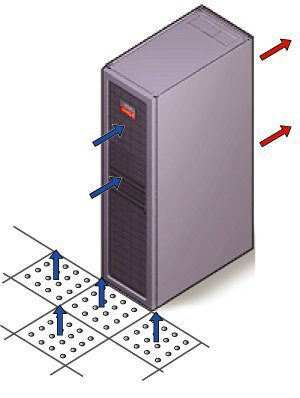Always provide adequate space in front of and behind the rack to allow for proper ventilation. Do not obstruct the front or rear of the rack with equipment or objects that might prevent air from flowing through the rack. Rack-mountable servers and equipment typically draw cool air in through the front of the rack and let warm air out the rear of the rack. There is no airflow requirement for the left and right sides due to front-to-back cooling.
If the rack is not completely filled with components, then cover the empty sections will filler panels. Gaps between components can adversely affect airflow and cooling within the rack.
Air conditioning facilities usually do not precisely monitor or control temperature and humidity throughout an entire computer room. Generally, monitoring is done at individual points corresponding to multiple exhaust vents in the main unit, and other units in the room. Special consideration should be paid to humidity when using underfloor ventilation. When underfloor ventilation is used, monitoring is done at each point close to an exhaust vent. Distribution of the temperature and humidity across the entire room is uneven.
Oracle Virtual Compute Appliance X3-2 has been designed to function while installed in a natural convection airflow. The following requirements must be followed to meet the environmental specification:
Ensure that there is adequate airflow through the system.
Ensure that the system has front-to-back cooling. The air intake is at the front of the system, and the air outlet is at the rear of the system.
Allow a minimum clearance of 914 mm (36 inches) at the front of the system, and 914 mm (36 inches) at the rear of the system for ventilation.
Use perforated tiles, approximately 400 CFM/tile, in front of the rack for cold air intake. The tiles can be arranged in any order in front of the rack, as long as cold air from the tiles can flow into the rack. Inadequate cold airflow could result in a higher intake temperature in the system due to exhaust air recirculation. The following is the recommended number of floor tiles:
Four floor tiles for Oracle Virtual Compute Appliance X3-2 with up to 25 compute nodes (fully loaded)
Three floor tiles for Oracle Virtual Compute Appliance X3-2 with up to 16 compute nodes (half loaded)
One floor tile for Oracle Virtual Compute Appliance X3-2 with 8 compute nodes (quarter loaded)
Figure 2.1 shows a typical installation of the floor tiles in a data center for Oracle Virtual Compute Appliance X3-2 with more than 16 compute nodes.
